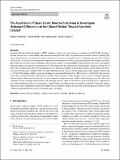Files in this item
The application of quasi-elastic neutron scattering to investigate hydrogen diffusion in an iron-based Fischer-Tropsch synthesis catalyst
Item metadata
| dc.contributor.author | Davidson, Alisha L. | |
| dc.contributor.author | Webb, Paul B. | |
| dc.contributor.author | Silverwood, Ian P. | |
| dc.contributor.author | Lennon, David | |
| dc.date.accessioned | 2020-04-21T15:30:03Z | |
| dc.date.available | 2020-04-21T15:30:03Z | |
| dc.date.issued | 2020-04-07 | |
| dc.identifier | 267545534 | |
| dc.identifier | c6cf12d8-7be6-4953-b791-75a64dbec6d1 | |
| dc.identifier | 000524390000001 | |
| dc.identifier | 85083375788 | |
| dc.identifier.citation | Davidson , A L , Webb , P B , Silverwood , I P & Lennon , D 2020 , ' The application of quasi-elastic neutron scattering to investigate hydrogen diffusion in an iron-based Fischer-Tropsch synthesis catalyst ' , Topics in Catalysis , vol. First Online . https://doi.org/10.1007/s11244-020-01259-2 | en |
| dc.identifier.issn | 1022-5528 | |
| dc.identifier.other | ORCID: /0000-0003-2532-344X/work/72842809 | |
| dc.identifier.uri | https://hdl.handle.net/10023/19832 | |
| dc.description | Sasol Ltd., (PGRS-3) the University of Glasgow and the Engineering and Physical Sciences Research Council (EP/P505534/1) are thanked for the provision of postgraduate studentship (ALD). The STFC Rutherford Appleton Laboratory is thanked for access to neutron beam facilities (RB1720188) [26]. The Royal Society are thanked for the provision of an Industrial Fellowship (PBW). | en |
| dc.description.abstract | Iron-based Fischer–Tropsch synthesis (FTS) catalysts evolve in situ on exposure to synthesis gas (CO & H2) forming a mixture of iron oxides, iron carbides and carbonaceous deposits. Recently, the application of inelastic neutron scattering has shown the progressive formation of a hydrocarbonaceous overlayer during this catalyst conditioning period. The evolving nature of the catalyst alters the proportion of phases present within the catalyst, which may influence the transport of hydrogen within the reaction system. Preliminary quasi-elastic neutron scattering (QENS) measurements are used to investigate hydrogen diffusion within an un-promoted iron FTS catalyst that has experienced varying levels of time-on-stream (0, 12 and 24 h) of ambient pressure CO hydrogenation at 623 K. Measurements on the catalyst samples in the absence of hydrogen show the unreacted sample (t = 0 h) to exhibit little increase in motion over the temperature range studied, whereas the t = 12 and 24 h samples exhibit a pronounced change in motion with temperature. The contrast is attributed to the presence of the afore-mentioned hydrocarbonaceous overlayer. Measurements on the samples in the presence of liquid hydrogen show hydrogen diffusional characteristics to be modified as a function of the catalyst conditioning process but, due to the complexity of the evolving catalyst matrix, the hydrogen motion cannot be attributed to a particular phase or component of the catalyst. Problems in the use of hydrogen as a probe molecule in this instance are briefly considered. Coincident neutron diffraction studies undertaken alongside the QENS measurements confirm the transition from hematite pre-catalyst to that of Hägg carbide during the course of extended times-on-stream. | |
| dc.format.extent | 8 | |
| dc.format.extent | 2009908 | |
| dc.language.iso | eng | |
| dc.relation.ispartof | Topics in Catalysis | en |
| dc.subject | Fischer-Tropsch synthesis | en |
| dc.subject | Quasi-elastic neutron scattering | en |
| dc.subject | Hydrogen diffusion | en |
| dc.subject | QD Chemistry | en |
| dc.subject | DAS | en |
| dc.subject.lcc | QD | en |
| dc.title | The application of quasi-elastic neutron scattering to investigate hydrogen diffusion in an iron-based Fischer-Tropsch synthesis catalyst | en |
| dc.type | Journal article | en |
| dc.contributor.sponsor | The Royal Society | en |
| dc.contributor.institution | University of St Andrews. School of Chemistry | en |
| dc.identifier.doi | 10.1007/s11244-020-01259-2 | |
| dc.description.status | Peer reviewed | en |
| dc.identifier.grantnumber | IF140013 | en |
This item appears in the following Collection(s)
Items in the St Andrews Research Repository are protected by copyright, with all rights reserved, unless otherwise indicated.

